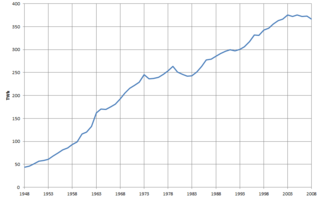
In the electricity sector in the United Kingdom the National Grid is the high-voltage electric power transmission network serving Great Britain, connecting power stations and major substations and ensuring that electricity generated anywhere on it can be used to satisfy demand elsewhere. The network covers the great majority of Great Britain and several of the surrounding islands. Notably, it does not cover Ireland; Northern Ireland is part of a single electricity market with the Republic of Ireland.
https://new.abb.com/systems/hvdc/hvdc-light

National Grid plc is a British multinational electricity and gas utility company headquartered in Warwick, United Kingdom. Its principal activities are in the United Kingdom and Northeastern United States. It has a primary listing on the London Stock Exchange, and is a constituent of the FTSE 100 Index. It has a secondary listing on the New York Stock Exchange.
The East–West Interconnector is a 500 MW high-voltage direct current submarine and subsoil power cable which connects the Irish and British electricity markets. The project has been developed by the Irish national grid operator EirGrid.

The synchronous grid of Continental Europe is the largest synchronous electrical grid in the world. It is interconnected as a single phase-locked 50 Hz mains frequency electricity grid that supplies over 400 million customers in 24 countries, including most of the European Union. In 2009, 667 GW of production capacity was connected to the grid, providing approximately 80 GW of operating reserve margin. The transmission system operators operating this grid formed the Union for the Coordination of Transmission of Electricity (UCTE), now part of the European Network of Transmission System Operators for Electricity (ENTSO-E).
TenneT is a transmission system operator in the Netherlands and in a large part of Germany.
Energinet is the Danish national transmission system operator for electricity and natural gas. It is an independent public enterprise owned by the Danish state under the Ministry of Climate and Energy. Energinet has some 1150 employees, and its headquarters are located in Erritsø near Fredericia in Jutland. The gas division is located in Ballerup near Copenhagen.

A wide area synchronous grid is a three-phase electric power grid that has regional scale or greater that operates at a synchronized frequency and is electrically tied together during normal system conditions. Also known as synchronous zones, the most powerful is the synchronous grid of Continental Europe (ENTSO-E) with 667 gigawatts (GW) of generation, while the widest region served being that of the IPS/UPS system serving countries of the former Soviet Union. Synchronous grids with ample capacity facilitate electricity market trading across wide areas. In the ENTSO-E in 2008, over 350,000 megawatt hours were sold per day on the European Energy Exchange (EEX).

BritNed is a 1,000 MW high-voltage direct-current (HVDC) submarine power cable between the Isle of Grain in Kent, the United Kingdom; and Maasvlakte in Rotterdam, the Netherlands.
The North Sea Offshore Grid, officially the North Seas Countries Offshore Grid Initiative (NSCOGI), is a collaboration between EU member-states and Norway to create an integrated offshore energy grid which links wind farms and other renewable energy sources across the northern seas of Europe. It is one of several proposed European super grid schemes.
The North Sea Link is a 1,400 MW subsea high-voltage direct current electricity cable under construction between Norway and the United Kingdom. It is a joint project of the transmission system operators Statnett and National Grid plc and is due to be completed in 2021.

Denmark's electrical grid is part of the Synchronous grid of Continental Europe. The electricity sector's generation relies on fossil energy and renewable energy: wind power, biogas, biomass and waste. Danish average consumption of electricity per person was 0.8 MWh less than EU 15 average in 2008. Denmark has average electricity costs in EU, but general taxes increase the price to the highest in Europe. In 2015, supply security was over 99.99%, among the highest in the world.

The United Kingdom has a National Grid that covers most of mainland Great Britain and several of the surrounding islands, as well as some connectivity to other countries. As of 2017 the electricity sector in the United Kingdom generation uses around 50% fossil fuelled power, roughly 20% nuclear power and 30% renewable power. Renewable power is showing strong growth, while fossil fuel generator use in general and coal use in particular is shrinking, with coal generators now mainly being run in winter due to pollution and costs.

The Malta–Sicily interconnector is the submarine power cable which connects the power grid of Malta with the Italian Transmission Network managed by Terna, which is part of the European grid.

The EuroAsia Interconnector is an interconnector between Greek, Cypriot, and Israeli power grids via the world's longest submarine power cable. It is a leading Project of Common Interest of the European Union and also priority Electricity Highway Interconnector Project. The Interconnector is an energy highway bridging Asia and Europe. Regulatory approval of electricity interconnection and cost allocation between Cyprus and Greece on October 10, 2017. and March 21, 2018 is historic decision for Cyprus, ending electricity isolation of the last EU member state.
Viking Link is a planned 1,400 MW HVDC submarine power cable between Bicker Fen in Lincolnshire, the United Kingdom and Revsing in southern Jutland, Denmark.
Celtic Interconnector is a proposed 700 MW HVDC submarine power cable between the southern coast of Ireland and the north-west coast of France.

EuroAfrica Interconnector is an interconnector between Greek, Cypriot, and Egypt power grids via submarine power cable. The Interconnector is an energy highway bridging Africa and Europe. It will have a capacity to transmit 2,000 megawatts of electricity in either direction. Annual transmission capacity is 17.5 TWh, much more than annual production of Aswan Dam power stations. President of Egypt Abdel Fattah el-Sisi, President of Cyprus Nicos Anastasiades and the Prime Minister of Greece Alexis Tsipras met in Nicosia on November 21, 2017 and showed their full support for the EuroAfrica Interconnector pointing out its importance for energy security of three countries.












